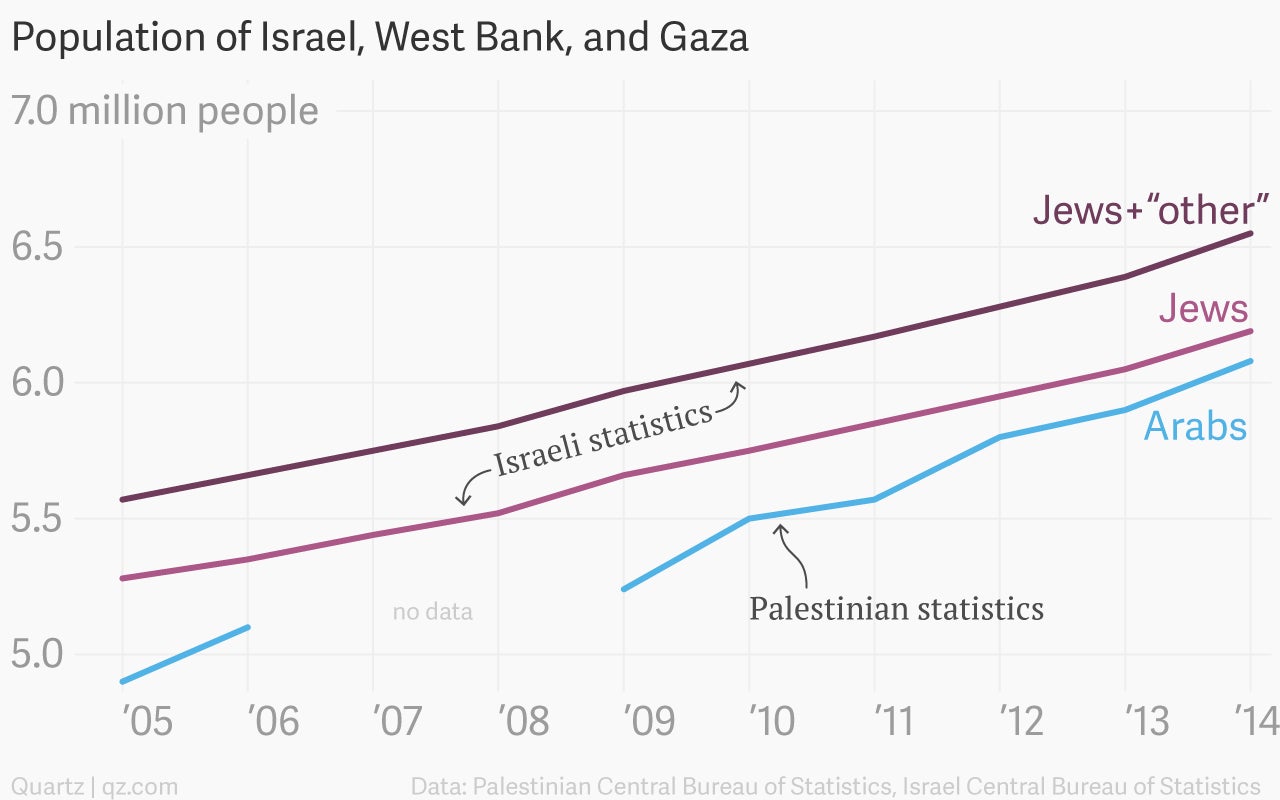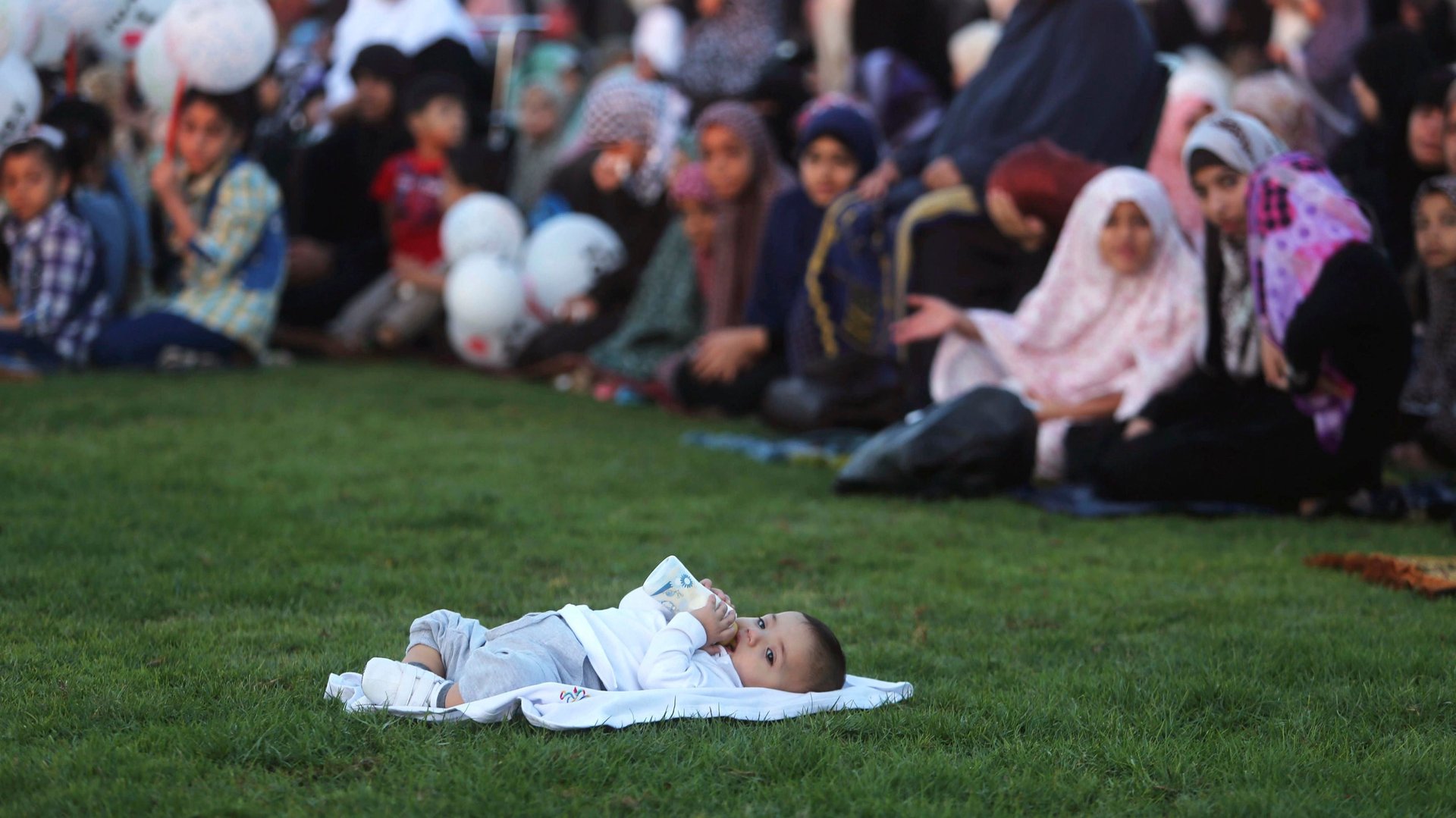Here are all the times the Palestinians have predicted they’ll outnumber Jews in Israel-Palestine
“Palestinians will outnumber Israeli Jews in 2016,” read the headline in Israeli newspaper Ha’aretz on Monday, Dec. 29. Rather conveniently, as the Palestinian Authority presents its latest bid for statehood to the UN security council, what Jewish Israelis call the “demographic problem”—the moment when they become a Jewish minority ruling over an Arab majority—is apparently just around the corner.


“Palestinians will outnumber Israeli Jews in 2016,” read the headline in Israeli newspaper Ha’aretz on Monday, Dec. 29. Rather conveniently, as the Palestinian Authority presents its latest bid for statehood to the UN security council, what Jewish Israelis call the “demographic problem”—the moment when they become a Jewish minority ruling over an Arab majority—is apparently just around the corner.
Or rather, it’s around the corner again.
Ha’aretz’s report was based on the latest annual population survey from the Palestinian Central Bureau of Statistics (PCBS). It predicts that two years hence, the Jewish and Palestinian populations between the Jordan river and the Mediterranean sea—that is to say, Israel, the West Bank, and Gaza—will reach parity at 6.42 million each.
The thing is, in 2012, the PCBS made a similar prediction, though its population estimate was slightly higher—6.5 million each by 2016—and Ha’aretz reported on it then too. In 2011, it predicted parity by 2015. In 2010, it predicted it by 2014—that is to say, now.
In fact, the Palestinian statistical body has been predicting that Palestinians will reach parity with Jews for at least a decade. And each time, the tipping point gets pushed back.
So are we ever going to get there?
Well, it certainly looks as if the Arab population has been catching up to the Jewish one. The graph below shows the total populations of Jews, Arabs, and “others”—meaning non-Jewish non-Arabs, such as the sizeable chunk of immigrants from the former Soviet Union who weren’t technically Jewish but got citizenship on the basis of having at least one Jewish grandparent.

On the other hand, Palestinian fertility rates have come down in the past decade, while those in the Jewish population are edging up. So while the gap may be closing, it’s closing ever more slowly:

So will the Palestinians ever catch up to the Jews? And does it even matter?
Let’s deal with the second question first. Supposedly the reason it matters is that when Palestinians outnumber Jews, Israel will, like apartheid South Africa, become a country with an ethnic minority ruling over a majority.
In reality, this is bunk. Whether one group outnumbers the other or not is beside the point. At the moment, about one-quarter of the Palestinians under Israeli control live in Israel and have full citizenship. The rest live in the West Bank and Gaza, and don’t. (And before you start arguing with me that Gaza is no longer under Israeli control, read the last section of this.) If you’re going to call it apartheid—a system of different rights for different ethnic groups—then it’s apartheid, regardless of whether one group is bigger or smaller than the other.
Nonetheless, to Jewish Israelis, the idea that the demographic tipping point will render the occupation somehow more apartheid-like and thus untenable has become common currency. So in that respect, if it leads to a shift in the Israeli national mood and Israeli policy, then it matters. The Palestinians, of course, understand this, which is why they keep on releasing data showing that the day of parity is approaching.
Which brings us back to the first question: Is it approaching?

Well, because demographics is such a fraught issue, the answer depends on whom you ask. Israelis who want Israel to keep its control of much of the West Bank tend to cite The Million-Person Gap (pdf), a 2006 study coordinated by Yoram Ettinger. It argued that, by over-counting or double-counting various groups, the PCBS was systematically exaggerating the Palestinian population by well over a million—in other words, that demographic parity won’t come for a very long time, if ever.
Those who want Israel to cede the West Bank to the Palestinians, on the other hand, tend to favor the views of people such as Sergio DellaPergola, who in 2011 predicted that the crossover point would come in 2015 (pdf, p. 40). If you’re wondering whom to believe, it’s worth noting that DellaPergola is one of Israel’s most respected academic demographers, while Ettinger served as a diplomat and head of the government press office.
Are there any independent assessments? None that seems definitive. Israel no longer does its own population surveys in the West Bank and Gaza; it handed that job over to the PCBS in the mid-1990s when the Palestinian Authority was established, and relies on the Palestinian estimates. The CIA World Factbook doesn’t cite its sources, but its numbers for the West Bank and Gaza are only around 100,000 people lower than the PCBS’s. The World Bank’s most recent figure, for 2010, was about 300,000 lower. The exact figure depends on how you count “Arabs” (the PCBS’s tally probably excludes Druze and Bedouin Arabs in Israel, while Israel’s probably includes them), whether you include non-Jewish non-Arabs in the “Jewish” category (Israel probably doesn’t, the Palestinians maybe do), and perhaps other factors.
Indeed, if you pick the right set of sources, you can show that the Palestinian population surpassed the Jewish one last year.
So what are we left with? Frankly, not a lot. At some point (if they haven’t already), Palestinians may, or may not, outnumber Jews between the Jordan river and the Mediterranean. If and when that point comes (if it hasn’t already), nobody will notice, because they will all be busy arguing over their own population surveys and projections. And even if by some miracle everyone came to agree that the magic moment had been reached, it would make zero difference to the legal status of Israel, Palestine, or the occupation.
So if you want my advice: Next time you read a headline about Palestinians being about to outnumber Jews, ignore it, and move briskly to the next one.
Note: If you want to root around in the data yourself, the links to PCBS population surveys, which include population, projected population, and fertility rates, are in the table above. Here are recent Israeli population data and fertility rates.